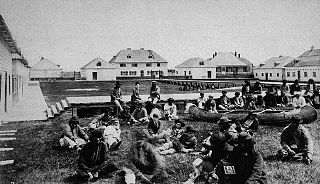Related Research Articles

The Cree are a North American Indigenous people. They live primarily in Canada, where they form one of the country's largest First Nations.
Wasagamack First Nation is an Oji-Cree First Nation band government in Manitoba, Canada. As of December 2014 the registered population of the Wasagamack First Nation was 2,017, of which 1,823 lived on their own reserve.
Roseau River Anishinabe First Nation is an Ojibway First Nation in southern Manitoba, Canada, situated around the Roseau River.
The Sagkeeng First Nation is a Treaty-1 First Nation in the Eastman Region of Manitoba, Canada, that is composed of the Anishinaabe people indigenous to the area at or near the Fort Alexander Indian Reserve #3 located along the Winnipeg River and Traverse Bay. Today, Sagkeeng holds territory in the southern part of Lake Winnipeg, 120 kilometres (75 mi) north of the city of Winnipeg, and on the mainland.

Norway House is a population centre of over 5,000 people, some 30 km (19 mi) north of Lake Winnipeg, on the bank of the eastern channel of Nelson River, in the province of Manitoba, Canada. The population centre shares the name Norway House with the northern community of Norway House and Norway House 17, a First Nation reserve of the Norway House Cree Nation. Thus, Norway House has both a Chief and a Mayor.
York Factory First Nation —sometimes referred to as York Landing First Nation or York Factory Cree Nation—is a First Nations community in northern Manitoba, Canada.

Poplar River First Nation is an Ojibwa First Nation in Manitoba, Canada. It is named after the Poplar River, which is the main river on which it resides.

The Long Plain First Nation is an Ojibway and Dakota First Nations band government in Manitoba, Canada.

Division No. 19, also informally known as North East Manitoba, is a census division within the Province of Manitoba, Canada. Unlike in some other provinces, census divisions do not reflect the organization of local government in Manitoba. These areas exist solely for the purposes of statistical analysis and presentation; they have no government of their own.

The Bloodvein First Nation is a First Nations community located on the east side of Lake Winnipeg, along the Bloodvein River in Manitoba, Canada. As of 2019, the community had a population of 1,176.
Wabaseemoong Independent Nations or more fully as the Wabaseemoong Independent Nations of One Man Lake, Swan Lake and Whitedog, is an Ojibway First Nation band government who reside 120 km northwest of Kenora, Ontario and 13 kilometres (8.1 mi) east of the Ontario-Manitoba border of northwestern Ontario, Canada. As of December 2018, the First Nation had a population of 2,000 registered people, of which their on-Reserve population was 1200 registered members and approximately 100 non-Band members.
Hollow Water First Nation is an Anishinaabe (Ojibwa) First Nation located on the east side of Lake Winnipeg, Canada, 75 km (47 mi) north of Pine Falls, Manitoba, and 217 km (135 mi) north of Winnipeg.
The Naicatchewenin First Nation, also known as the Anishinaabeg of Nagaajiwanaang and formerly known as Northwest Bay First Nation, inhabited a region in Ontario that was cited in the Northwest Angle Treaty of 1873, also known as Treaty 3. Nagaajiwanaang is located approximately 60 kilometres (37 mi) northwest of Fort Frances, with the community of Devlin 50 kilometres (31 mi) to the south on Highway 11. The city of Thunder Bay lies 420 kilometres (260 mi) to the east and Winnipeg is 450 kilometres (280 mi) to the northwest.
Pauingassi First Nation is an Anishinaabe (Saulteaux/Ojibwa) First Nation community located approximately 280 kilometres (170 mi) northeast of Winnipeg, Manitoba, and 24 kilometres (15 mi) north of Little Grand Rapids, Manitoba, on a peninsula jutting southward into Fishing Lake, a tributary of Berens River.
Brokenhead Ojibway Nation is an Anishinaabe (Saulteaux/Ojibwa) First Nation located approximately 64 kilometres (40 mi) northeast of Winnipeg, Manitoba.
Little Grand Rapids First Nation is a remote Anishinaabe (Saulteaux/Ojibwa) First Nation community in northeast Manitoba, located approximately 370 kilometres (230 mi) northeast of Winnipeg.
Bunibonibee Cree Nation, formerly known as Oxford House First Nation and as Oxford House Band of Indians, is a First Nation located along the eastern shoreline of Oxford Lake at the headwaters of the Hayes River and is approximately 950 kilometres (590 mi) northeast of Winnipeg, Manitoba.
The Mathias Colomb Cree Nation (MCCN) —also known as Mathias Colomb First Nation, Mathias Colomb (Cree) First Nation, and Pukatawagan/Mathias Colomb Cree Nation—is a remote First Nations community in northern Manitoba, located 210 km (130 mi) north of The Pas and 819 km (509 mi) northwest of Winnipeg, Manitoba.
Berens River First Nation is a First Nations band government in Manitoba, Canada. The First Nation has two reserves: Berens River 13 and Pigeon River 13A, located in the boreal forest east of Lake Winnipeg. The First Nation is governed by a chief and five councillors.
The Southeast Resource Development Council (SERDC) is a tribal council in eastern Manitoba, Canada, representing 8 First Nation communities located to the south and east of Lake Winnipeg.
References
- 1 2 3 "SERDC - Black River". www.serdc.mb.ca. Retrieved 2021-08-13.
